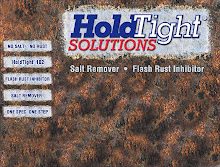See Myths about Salts above
Sunday, September 5, 2010
HoldTight 102 vs ChlorRid: Very Different Indeed
HoldTight 102 vs ChlorRid: Very Different Indeed -- ChlorRid's voodoo science rebutted
Saturday, August 7, 2010
Our own documents about HT102
These include the Product Data Sheet, MSDS, and pieces on such topics as coverage, compatibility, UHP applications, removal of bicarbonate of soda abrasive residue, test summaries, testing protocol, etc.
Easy access to downloadable PDF files, no sign-in or password, or Facebook account required
Reports & articles on HoldTight 102
Easy access to reports & articles by others concerning HoldTight 102 -- downloadable PDF files, no sign-in or password or Facebook account required.
Wednesday, June 16, 2010
A selection of our own documents.
A number of our documents concerning HoldTight 102 are also available at:
You must have a Facebook account to access the files this way -- or you can sign up for Facebook after you click on this link.
If and when we are able to do so, we will make these and others available on this HoldTight Solutions blog. For more, go to www.holdtight.com
Others report on using HoldTight 102 salt remover/flash rust inhibitor
Here are several reports produced by third parties concerning the use and effectiveness of HoldTight 102:
http://www.scribd.com/document_collections/2492418
If and when it becomes possible to do so, we will publish the text of these articles and others on this HoldTight Solutions blog.
http://www.scribd.com/document_collections/2492418
You must have a Facebook account to access the files this way -- or you can sign up for Facebook after you click on this link.
If and when it becomes possible to do so, we will publish the text of these articles and others on this HoldTight Solutions blog.
Wednesday, May 12, 2010
HoldTight 102 is not a coating: it is NOT "applied"
One of the most common misconceptions about HoldTight 102 salt remover / flash rust inhibitor is that it can be "sprayed on" or otherwise applied like a coating. NOT SO! Sure, it is physically possible to do so, but its effect on the surface if used that way will be of little value. And if it is "put on" this way at full strength (i.e., without at least a 50 to 1 dilution -- potable water to 102) it will not evaporate and will become a residue that will be a problem for some coatings.
The key to using 102 effectively is to dilute it properly AND to pressure wash the surface with the water + 102 fluid -- we say "treated water" -- the more pressure the better but the water volume need not be greater than 1 gallon per minute -- a common flow rate for pressure washers. Higher pressure improves performance, higher volume doesn't help add much. Most off-the-shelf (at Home Depot or Loew's, for example) can easily generate 1500 psi of pressure with a flow rate of 1 gallon per minute. Industrial washers can go much higher 5,000 psi or above and they are more efficient.
Why are pressure and flow important? Simply because 102 is a washing agent, a surfactant like soap, but UNLIKE soap, it leaves no residue if allowed to evaporate with the water that contains it. Forcing the water with the 102 into the profile or pores of the surface results in more thorough cleaning. When the surface is dry, the 102 is gone. There is nothing to remove. You are ready to apply your primer or coating or you can wait several days without seeing flash rust.
The HoldTight 102 Team
Monday, June 1, 2009
New Tool for HoldTight 102 users
We hope this will be a useful way of sharing current information about HoldTight 102, augmenting the website, our CD, and printed literature. We are (almost) always available, however at 713-266-9339 or 800-319-8802 or at info@holdtight.com
The HoldTight 102 Team
Subscribe to:
Posts (Atom)
